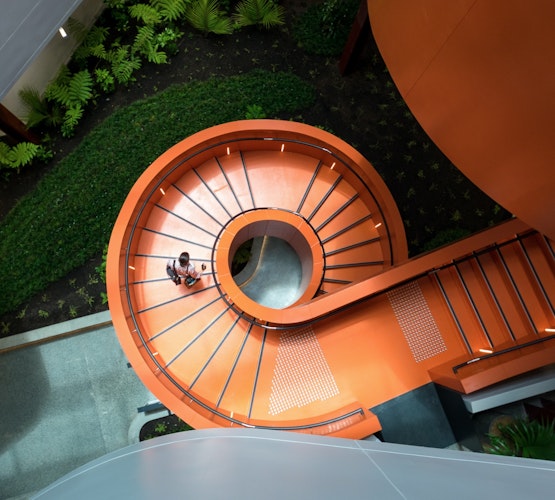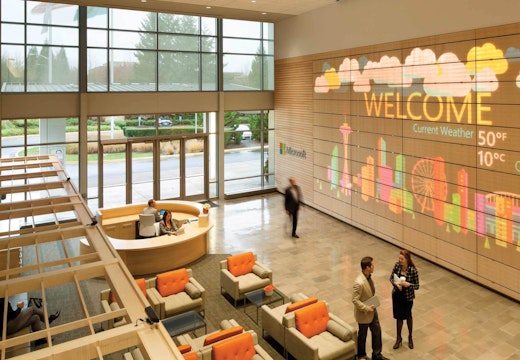Sonic branding: the next buzz for workplace experience
The B:Hive in Auckland, New Zealand, rethinks the suburban work campus by putting great sounds as its heart. Laurie Aznavoorian of architects BVN reflects on a coming era of sonic architecture
My work is a drop in the bucket, a speck in the cosmos. I’m just a pea in a pod, another cog in the wheel. Maybe a more appropriate descriptor of insignificance for me might be a tool in the shed – a very blunt one. Idioms aside, being a bee in the hive need not be a harbinger of doom. Particularly when you’re a bee in the hive at the B:Hive in Auckland, New Zealand.
After spending time at this new workplace collective, I felt anything but paltry. Buzzing in the swarm left me with a mild sense of belonging, even though I didn’t know a soul in the place. B:Hive is home to several disparate tenants, each has their own secured office space, but they share amenity. Unlike the stereotypical coworking cohort, patrons of the B:Hive come from established companies that fall outside the sexy start-up epithet.
Shared community
Tenants at B:Hive are not only attracted to the opportunities for networking, but also the flexibility in its space delivery model which allows offices to expand or contract twice a year. More importantly, tenants are part of a wider community that shares the same values and creates a vibrant atmosphere a far cry from traditional, dull suburban office parks.
B:Hive has placed community and people firmly at the centre of design. It has opted for daylight, fresh air and amazing amenity: break areas, technology enabled meeting rooms, places to focus, hold assemblies and play ping pong. It has acknowledged the need for different work settings with a plethora of varying furniture groupings which support new agile working models. Yet, its most striking feature is its bright orange corkscrew staircase located in the heart of the space which creates more fluid and open access to different floors and solidifies a sense of community in the building.
‘In the cross-pollination of humanity anything goes’
Tenants and guests are greeted into the B:Hive by The Good Side – a conglomeration of food and beverage purveyors. Shared outdoor seating encourages customers, or even non-customers, to seamlessly flow between the dozen or so retailers and permeable boundaries with surrounding buildings suck in neighbouring occupants and residential areas. People can intermingle and the variety of users is what makes the overall experience unique. In the cross-pollination of humanity anything goes, this community feel coupled with B:Hive’s very deliberate non-precious aesthetic and a welcoming vibe is what gives B:Hive its buzz.
The buzz of sonic branding
There is a real buzz too, an omnipresent background noise in both workplace and at The Good Side serves as an aggregate binding the incongruent parts together. The soundtrack to B:Hive has been carefully curated, it is the brainchild of the CEO, who amongst other things, was once a DJ. This backdrop of noise is far from distracting, in fact I found the sound honed my focus and made me feel less completely alone.
‘Sound is an effective and very underutilised tool in design’
Human beings for the most part experience sound subconsciously, we tend to focus on visual aspects and pay little attention to the sounds that impact our experiences. Like most things, these can be positive or negative because noise can trigger emotional responses. It is why jingles have historically been an integral part of branding.
Beyond catchy tunes, sound is an effective and underutilised tool in design. The strategic use of sound to convey rich, emotional stories is referred to as sonic branding. It is the focus of agencies such as Man Made Music in New York, who worked with AT&T to identify its brand’s sound. They’re responsible for the six-note chime used in ringtones, commercials and in-store music.
The science behind the sound
Scientists have experimented with integrating more of our senses to improve experiences. One study conducted at the Crossmodal Research Laboratory at Oxford in 2010 drew connections between different tones and pitches and the way we experience basic tastes: sweet, sour, salty and bitter. By pairing music tracks with tastes, they found sound altered a person’s perception of food.
The cause is a rare neurological phenomenon, synaesthesia, that causes one sensory pathway to be experienced through another. Chefs like Heston Blumenthal, who mess with the relationship between auditory and olfactory senses and taste, are on to this. So is sound designer Felipe Carvalho, who used synaesthesia to compile a soundtrack for eating, so now you can purchase ‘Sound of Chocolate’ online.
Onto the sonic bandwagon
Venues in the UK such as Spiritland are jumping on the sonic bandwagon by touting their restaurant-bar as a place to have an acoustic eating experience. Conceived as a ‘dining room of sonic architecture’, Spiritland has velvet curtains, rounded leather booths, custom ceilings and walls, all to enhance one’s experience. Superb sound quality and acoustics are a must and as important as how food tastes.
At least six more venues in London are following this new trend of creating high-level listening, eating and drinking experiences. With top-notch sound systems and lots of vinyl they’re an audiophile’s dream. Some claim it heralds a return of quality over convenience, inviting us to engage with music in a more purposeful way.
I suspect the intent of music at B:Hive had little to do with sonic branding; nevertheless, its impact leads me to believe sonic branding and super experiences may be more than new squares on the workplace lingo bingo board.
As we enter new, exciting times, it’s important to heed the advice of experts in sonic branding who say a little bit of sound goes a long way. In a world where we are constantly surrounded by noise, they advise that we should think strategically about how we use sound to enhance the experience. As more emphasis is placed on employee experience, will we see a new era of sonic architecture entering the workplace?
Sources
Smith, Jessica and Walker, Josh; ‘Listening Clubs’
Sedacca, Matthew; ‘Sonic Seasoning is the Growing Scientific Field That Uses Sound to Make Food Taste Better’; Quartz; December 24, 2016
Zemni, Hakim; ‘A Sonic Branding Revolution is Going on and You Are Not Ready For it’; Insights Consulting; November 29, 2018
Molloy, Shannon; ‘Victoria Police Hunting for Bourke St Hero dubbed ‘Tolley Man’ Over Alleged Burglaries’; Newscorpaustralia.com; November 16, 2018
‘What Does Your Brain Sound Like?’; Fast Company Co-Design; October 22, 2014








